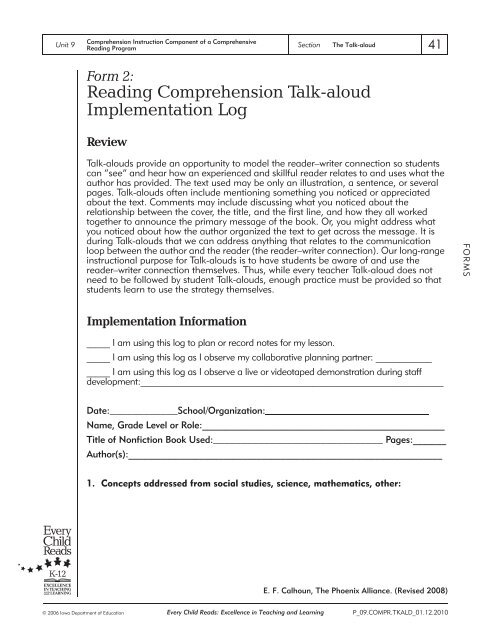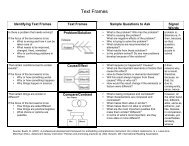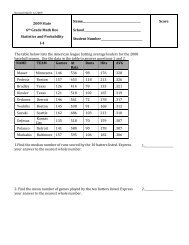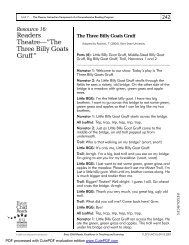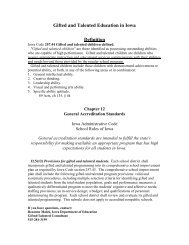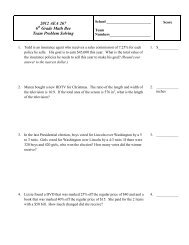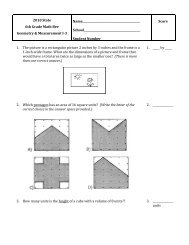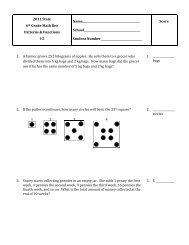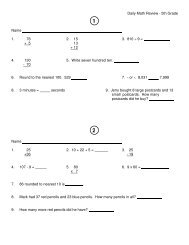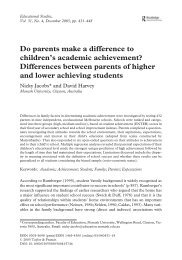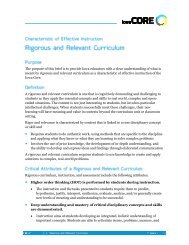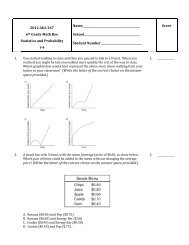Reading Comprehension Talk-aloud Implementation Log - AEA 267
Reading Comprehension Talk-aloud Implementation Log - AEA 267
Reading Comprehension Talk-aloud Implementation Log - AEA 267
You also want an ePaper? Increase the reach of your titles
YUMPU automatically turns print PDFs into web optimized ePapers that Google loves.
Unit 9<br />
<strong>Comprehension</strong> Instruction Component of a Comprehensive<br />
<strong>Reading</strong> Program<br />
Section The <strong>Talk</strong>-<strong>aloud</strong> 41<br />
Form 2:<br />
<strong>Reading</strong> <strong>Comprehension</strong> <strong>Talk</strong>-<strong>aloud</strong><br />
<strong>Implementation</strong> <strong>Log</strong><br />
Review<br />
<strong>Talk</strong>-<strong>aloud</strong>s provide an opportunity to model the reader–writer connection so students<br />
can “see” and hear how an experienced and skillful reader relates to and uses what the<br />
author has provided. The text used may be only an illustration, a sentence, or several<br />
pages. <strong>Talk</strong>-<strong>aloud</strong>s often include mentioning something you noticed or appreciated<br />
about the text. Comments may include discussing what you noticed about the<br />
relationship between the cover, the title, and the first line, and how they all worked<br />
together to announce the primary message of the book. Or, you might address what<br />
you noticed about how the author organized the text to get across the message. It is<br />
during <strong>Talk</strong>-<strong>aloud</strong>s that we can address anything that relates to the communication<br />
loop between the author and the reader (the reader–writer connection). Our long-range<br />
instructional purpose for <strong>Talk</strong>-<strong>aloud</strong>s is to have students be aware of and use the<br />
reader–writer connection themselves. Thus, while every teacher <strong>Talk</strong>-<strong>aloud</strong> does not<br />
need to be followed by student <strong>Talk</strong>-<strong>aloud</strong>s, enough practice must be provided so that<br />
students learn to use the strategy themselves.<br />
FORMS<br />
<strong>Implementation</strong> Information<br />
_____ I am using this log to plan or record notes for my lesson.<br />
_____ I am using this log as I observe my collaborative planning partner: ____________<br />
_____ I am using this log as I observe a live or videotaped demonstration during staff<br />
development:_________________________________________________________________<br />
Date:____________School/Organization:<br />
Name, Grade Level or Role:___________________________________________________<br />
Title of Nonfiction Book Used:______________________________ Pages:_______<br />
Author(s):__________________________________________________________________<br />
1. Concepts addressed from social studies, science, mathematics, other:<br />
E. F. Calhoun, The Phoenix Alliance. (Revised 2008)<br />
© 2006 Iowa Department of Education<br />
Every Child Reads: Excellence in Teaching and Learning<br />
P_09.COMPR.TKALD_01.12.2010
Unit 9<br />
<strong>Comprehension</strong> Instruction Component of a Comprehensive<br />
<strong>Reading</strong> Program<br />
Section The <strong>Talk</strong>-<strong>aloud</strong> 42<br />
Form 2 (continued)<br />
<strong>Reading</strong> <strong>Comprehension</strong> <strong>Talk</strong>-<strong>aloud</strong> <strong>Implementation</strong> <strong>Log</strong><br />
2. Language arts concepts and processes represented/modeled in the text<br />
selection:<br />
3. How does the teacher model his or her use of what the author(s) provided in the<br />
text<br />
• Connections made to past learning or future content if appropriate to your<br />
purpose:<br />
FORMS<br />
• Listening activation (e.g., “Listen to the title and opening paragraph of…”<br />
“Listen to the beginning of… “Listen for how…”):<br />
• Read <strong>aloud</strong> the text you have selected, or, read and share if there are<br />
illustrations.<br />
• <strong>Talk</strong> about what appealed to you in how the author(s) presented the<br />
information. Point out the reader-writer connection (e.g., “I noticed the<br />
author… it made me think about…”).<br />
Be sure to stay focused, crisp, and concise—addressing only a few attributes at first.<br />
Students will need to be able to see the text as you discuss it. You may also want to post the<br />
list of attributes that drew you to this text.<br />
E. F. Calhoun, The Phoenix Alliance. (Revised 2008)<br />
© 2006 Iowa Department of Education<br />
Every Child Reads: Excellence in Teaching and Learning<br />
P_09.COMPR.TKALD_01.12.2010
Unit 9<br />
<strong>Comprehension</strong> Instruction Component of a Comprehensive<br />
<strong>Reading</strong> Program<br />
Section The <strong>Talk</strong>-<strong>aloud</strong> 43<br />
Form 2 (continued)<br />
<strong>Reading</strong> <strong>Comprehension</strong> <strong>Talk</strong>-<strong>aloud</strong> <strong>Implementation</strong> <strong>Log</strong><br />
4. What, if any, student application activity was used<br />
There are many appropriate student application activities, but remember the primary purpose of<br />
the <strong>Reading</strong> <strong>Comprehension</strong> <strong>Talk</strong>-<strong>aloud</strong> is to help students learn to use the reading/writing<br />
connection; therefore, many of your talk-<strong>aloud</strong>s should eventually lead students to identify their<br />
own model text and share its attributes.<br />
5. a. Reflections on the <strong>Reading</strong> <strong>Comprehension</strong> <strong>Talk</strong>-<strong>aloud</strong> and organization of the<br />
lesson:<br />
FORMS<br />
6. b. Reflections on student response:<br />
Please include a copy of the passage used for your <strong>Talk</strong>-<strong>aloud</strong>.<br />
<strong>Implementation</strong> Data<br />
In the last 5 days, have you worked with your collaborative planning partner to select and<br />
rehearse a <strong>Talk</strong>-<strong>aloud</strong><br />
____ Yes ____ No If “Yes,” how many times _____<br />
In the last 5 days, have you demonstrated a <strong>Talk</strong>-<strong>aloud</strong> (with students) for your<br />
collaborative partner<br />
____ Yes ____ No If “Yes,” how many times _____<br />
E. F. Calhoun, The Phoenix Alliance. (Revised 2008)<br />
© 2006 Iowa Department of Education<br />
Every Child Reads: Excellence in Teaching and Learning<br />
P_09.COMPR.TKALD_01.12.2010


